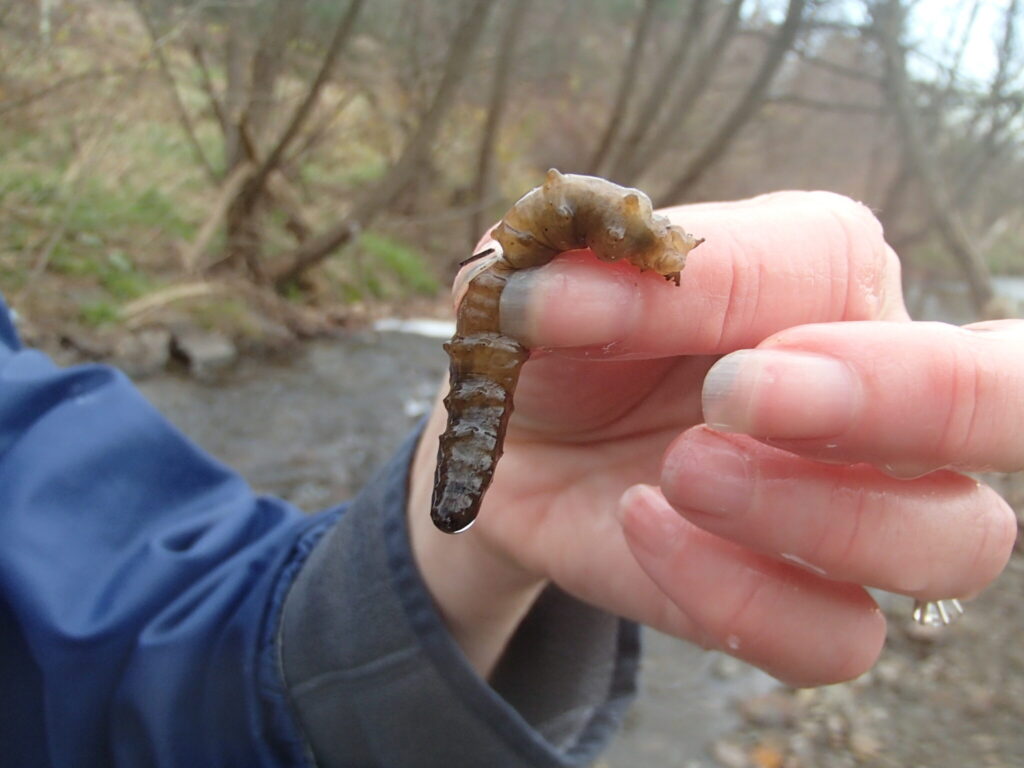May 2025 Macro of the Month: Crane Flies

Living on a trout stream in southeastern Minnesota, it doesn’t require too much effort to keep an eye on what’s hatching and when. However, it still caught me by surprise to see two adult craneflies on my bathroom floor early one morning in the first week of May. Maybe they got lost amidst the excitement of a brief reproductive trip in terrestrial territory?
Regardless, it reminded me how cool these sometimes-overlooked insects are and the important role they play in cold water stream ecosystems. Though adults can be mistaken for (very) oversized mosquitoes and larvae are not the most aesthetic of aquatic creatures, crane flies are harmless, ecologically important, and of interest to fly anglers.
What Are Crane Flies?
There are over 1,500 species of crane flies (Family Tipulidae) in North America, and dozens are known to inhabit the Driftless Area, north shore streams, and central forested watersheds of Minnesota. These larvae are widely distributed across Minnesota, particularly in areas with soft, silty streambanks, springy seeps, or leaf-littered floodplains.
As adults, crane flies are large, gangly insects with long legs, narrow wings, and a delicate appearance. Adults resemble giant mosquitoes but don’t bite or feed – in fact, many don’t eat at all. Their larval stage, however, is a different story – anything but slender or delicate. Larvae are robust sediment-dwelling detritivores and sometimes predators with thick, leathery exteriors. When I collect aquatic macroinvertebrates with kids, finding a crane fly larva as big as their pointer finger often elicits some shrieks and “ewws!” It is easy to see why local bait anglers often refer to them as Known as “water worms”. At that point, I will often pull out my phone to show them what an adult looks like – and as expected, they are surprised by the transformation in appearance!

A crane fly larvae collected from a stream. Credit: Berks Nature
Crane Fly Ecology in Trout Streams
In Minnesota trout streams, crane flies contribute to the food web both directly and indirectly. Crane fly larvae feed on decomposing organic matter, helping to process leaf litter and recycle nutrients. This is especially important in smaller headwater streams, where detritus-based food chains dominate.
Larval crane flies can reach sizes of 1–2 inches and are often a protein-rich snack for trout. I frequently found them in stomach samples while doing research on seasonal diets of trout in southeastern Minnesota – especially in early spring when other types of macroinvertebrate larvae are smaller-bodied and less abundant.
When and Where to Find Them
Crane fly larvae are present year-round in trout streams, particularly in mucky stream margins and slow eddies, springs and seeps where substrate is soft, and undercut banks and dense leaf packs. Adult crane flies tend to emerge in late spring through early fall, often at dusk. In northern Minnesota and along the north shore, adult emergence may peak later due to colder water temperatures whereas in the Driftless Area, some species emerge as early as April.
Fly Fishing with Crane Fly Imitations
Although crane flies aren’t often the centerpiece of a hatch chart, they absolutely deserve a place in your fly box – particularly in early season or when trout seem reluctant to rise to more common dry flies.
Recommended Patterns:
- Larval Imitations:
- Worm-style nymphs tied in brown, olive, or gray
- San Juan Worms in dark earth tones
- Czech nymph-style patterns with lead wire for deep drift
- Adult Imitations:
- Crane Fly Dry – a variety of long-legged dry flies that resemble a mosquito with a bigger body
Tips for Fishing
- Early Season Nymphing: Drift a crane fly larva along the bottom in March through April, when water is cold and clear. Add a bit of split shot to get deep into runs where trout hunker down.
- Post-Rainfall Edges: After a spring or summer rain, high flows often dislodge crane fly larvae from banks. Try a larval imitation in soft seams or margins.
- Twilight Dry Fly Action: If you see large, gangly insects in the air near the stream in the evening, tie on a crane fly dry and skate it across the surface – especially near grassy banks.
- Sight Fishing: In low, clear water, watch for trout cruising near soft mud margins. A well-placed crane fly nymph might be what they are looking to snack on.
Crane flies may not get the same attention as the more high-profile mayfly and caddis hatches, but their ecological value and angling potential are still pretty great!
